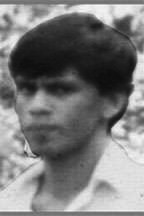Lalith Wijerathna
Lalith Wijerathna (Lalith Wijeratna. Lalith Wijeratne alias Aravinda) was a Sri Lankan politician. He was a member of the JVP party in the period 1983-1990. He was known to be appointed as the third leader[1] of the JVP after Rohana Wijeweera and Saman Piyasiri Fernando. Wijerathna was killed in 1990.
Lalith Wijerathna | |
|---|---|
ලලිත් විජේරත්න | |
 | |
| 3rd Leader of Janatha Vimukthi Peramuna | |
| In office 27 December 1989 – 1 January 1990 | |
| Preceded by | Saman Piyasiri Fernando |
| Succeeded by | Somawansa Amarasinghe |
| Personal details | |
| Born | 1958 Divulapitiya, Sri Lanka |
| Died | 1990 (aged 32) Kandy, Sri Lanka |
| Nationality | Sri Lankan |
| Political party | Janatha Vimukthi Peramuna |
| Education | Hunumulla Central College |
| Alma mater | University of Peradeniya |
| Occupation | Politician |
Family life
Lalith Wijerathna was born in Divulapitiya of the Western Province in 1958. Wijerathna belonged to a family of five. His father was a farmer and the mother was a housewife. He had an elder brother and a younger brother named Ranjith Wijerathna who was a laborer at a textile factory. In December, the government security forces raided Lalith Wijerathna's home with the intention of arresting him. However, the forces could not find him, so they arrested the brother Ranjith Wijerathna and his father instead. Subsequently, the father was released, but the brother disappeared. It is believed that Ranjith Wijerathna had been tortured and killed by the government security forces.
Education
Lalith Wijerathna studied at the Hunumulla Central College (near Divulapitiya) until the GCE Advanced level examination and entered the Science Faculty of University of Peradeniya in 1980. However, he did not complete his studies at the university due to his heavy engagement in politics. His studentship was revoked after a decision from the Udulagama Commission which was set up to probe student agitations at the University of Peradeniya in 1983.
Career
Lalith Wijerathna started his political career as a student activist of Socialist Student Union (SSU), the student wing of the JVP. After the expulsion from the university he became a full-time JVP member.
In 1982, when the JVP's leader Rohana Wijeweera contested the presidential election, Wijerathna supported his campaign. Even though he was a skillful organizer and a charismatic leader, Wijeratha was little known outside the party. In mid 1989, after the killing of Sumith Athukorala, a prominent politbureau member of the JVP, Wijerathna was believed to be promoted to the political bureau to fill up the vacant position. During 88-89 period, he was both the political and military wing leader of Anuradapura, Polonnaruwa and Trincomale.
In November 1989, after Rohana Wijeweera's execution,[2] the remaining leaders including Saman Piyasiri Fernando, Lalilth Wijerathna, Upali Jayaweera, Ranjitham Gunaratnam, Gamini Wijegunasekara and Shantha Bandara tried to regroup. This attempt was made under the leadership of Saman Piyasisri Fernando. However, the government forces managed to capture Saman Piyasisri and subsequently killed him on 27. December 1989. After the capture of Saman Piyasiri, the leadership of the JVP was transferred to Lalith Wijerathna. It is believed that Wijerathna was captured in Colombo by a special police team from Kandy either late December 1989 or early January 1990. At a later date in January he was executed by his captors most probably in Kandy.
At the time of his death in January 1990, Lalith Wijerathna was believed to be around 32 years old.
Bibliography
- Rohan Gunarathna (1990), Sri Lanka, a lost revolution, Institute of fundamental studies ISBN 955-26-0004-9
- C. A. Chandraprema (1991) Sri Lanka, The Years of Terror- The JVP insurrection 1987-1989, Lake House Bookshop, ISBN 955-9029-03-7
- S. Puvimanasinghe (2004), An Exceptional Collapse of the Rule of Law, Told through stories by families of the disappeared in Sri Lanka, Asian Human Rights Commission, ISBN 962-8161-06-7
References
- "History of the JVP" (PDF). www.jvpsrilanka.com. Archived from the original (PDF) on 11 April 2015. Retrieved 28 March 2015.
- "Sri Lanka Government Forces Kill Leader of Sinhalese Group". The New York Times. Retrieved 28 October 2014.